
Members:
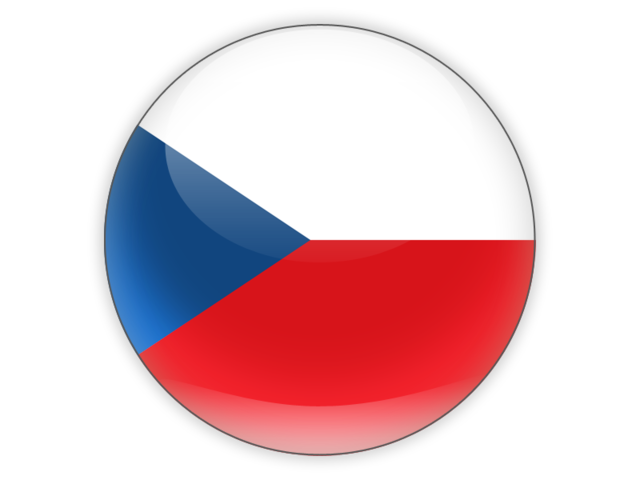
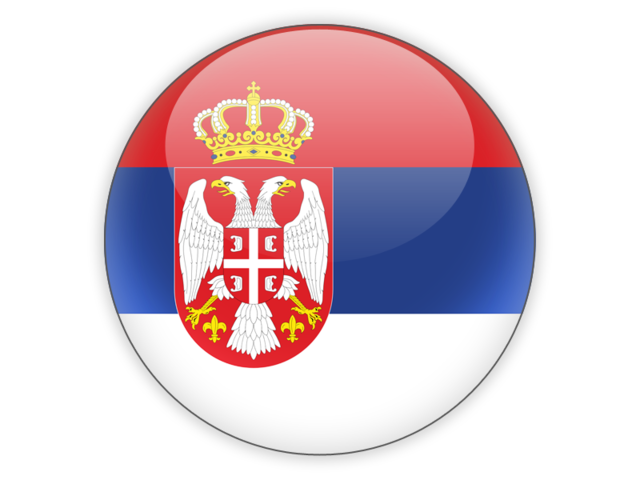

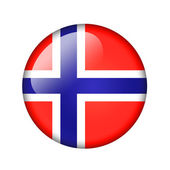





Dictionary: (all members)
 dýně
dýně  Бундева
Бундева  Gresskar
Gresskar  гарбуз /harbuz/
гарбуз /harbuz/ Dovleac
Dovleac  gogra/გოგრა
gogra/გოგრა
 тиква
тиква
A) Description, varieties, aroma, taste,...

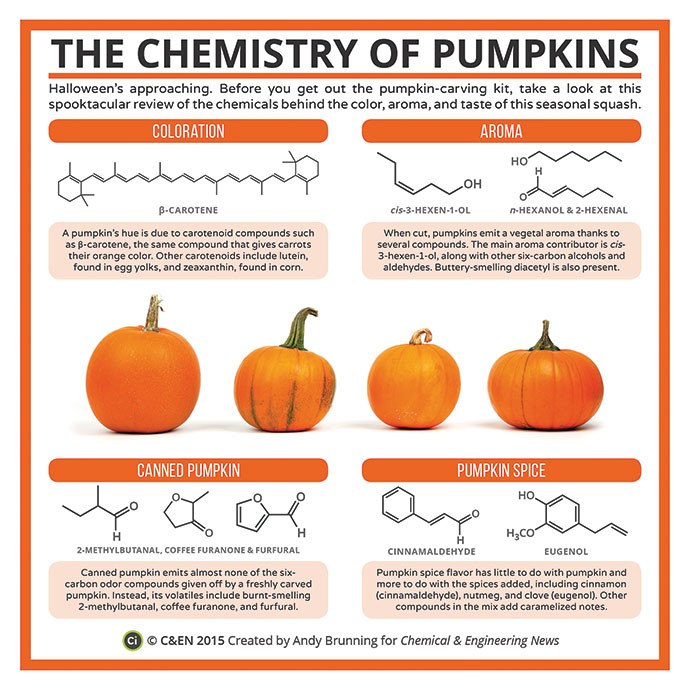
Infographic source http://cen.acs.org/articles/93/i40/Periodic-Graphics-Chemistry-Pumpkins.html
 B) Real and Art Picture (+ information about the artist)
B) Real and Art Picture (+ information about the artist)
 C) In 10 steps how to grow a pumpkin
C) In 10 steps how to grow a pumpkin
 D) In which countries worldwide is it grown (produced)? Cultivation history
D) In which countries worldwide is it grown (produced)? Cultivation history
Pumpkin Production world Wide
|
Country
|
|
|
|
China
|
5700 000
|
|
|
India
|
3500 000
|
|
|
Russia
|
953840
|
|
|
United States
|
786980
|
|
|
Egypt
|
651 859
|
|
1. Pumpkins are a member of the cucurbitaceae family, which also includes squash, cantaloupes, cucumbers, watermelons, and gourds. Pumpkins originated in America. Fragments of stems, seeds, and fruits have been identified and recovered from cliff dweller ruins in the southwestern United States. Some pumpkin varieties may have originated in Mexico and Central America, while others probably developed in Peru, Colombia, and Ecuador. Some of these pumpkin and squash varieties probably have been cultivated as long as maize (corn), since around 3500 B.C. Pumpkins are 90 percent water and range in size from less than a pound to over 1,000 pounds with the largest pumpkin ever grown weighing 1,140 pounds..
2. Pumpkins are seen as a profitable opportunity by many farmers. Because of this, pumpkin acreage has expanded greatly in recent years and competition in the pumpkin market is increasing. Around 1.5 billion pounds of pumpkins are produced on 75,000 acres in the United States annually. In 2009, pumpkins harvested from 44,100 acres were valued at $102.7 million USD. According to the University of Illinois, 90 percent of the pumpkins grown in the United States are raised within a 90-mile radius of Peoria, Illinois. Most pumpkins are processed into canned pumpkin and canned pie mix. In 2005, Illinois was number one among the top five pumpkin producing states, with almost 4.97 million pounds, followed by California with almost 1.6 million pounds, Ohio with 1.33 million pounds, Pennsylvania with 1.31 million pounds and Michigan with 854 thousand pounds.
3. Hollowed-out pumpkins, called jack-o-lanterns can be traced back to the people in Ireland and England who carved out beets, potatoes, and turnips to use as lanterns around this festive time. They were named for a miser named Jack who could not enter heaven and played jokes on the devil. The story starts with a mean and stingy man named Jack. He liked to play tricks on people, and even went so far as played games on the Devil. When they were having a drink, Jack tricked the Devil into turning into a sixpence to pay for the drink. But, Jack put the money inside his pocket, beside a cross. When he had the Devil trapped, he made the Devil promise to not take his soul for a year. The following year, Jack met the Devil while he was walking. Before agreeing to walk with him, Jack asked the Devil to climb a tree and get him an apple. He then imbibed a cross on the tree so that the Devil would once again be trapped. And then he made the Devil promise him that his soul would not ever be taken. When Jack died, he was denied entrance into either Heaven or Hell. He was doomed to wander around the Earth until Judgment Day. Because it was so dark, Jack asked the Devil to give him a tiny light to light his way. The Devil hesitantly put gave him a turnip with a little light inside it. Since then, he was known as Jack of the Lantern or Jack o' Lantern.
4. The estimated area of pumpkins planted in Canada in 2010 is 2,922 hectares (7,220 acres). The estimated farm gate value of these pumpkins in 2009 was $15.3 million (CAD).
5. The total production of pumpkins by major pumpkin-producing states in 2008 was 1.1 billion pounds, 496 million pounds of which were produced in Illinois (around 90 to 95% of the processed pumpkins in the United States are grown in Illinois). Eighty percent of the pumpkin supply in the United States is available in October.
 E) Import and export in Europe
E) Import and export in Europe
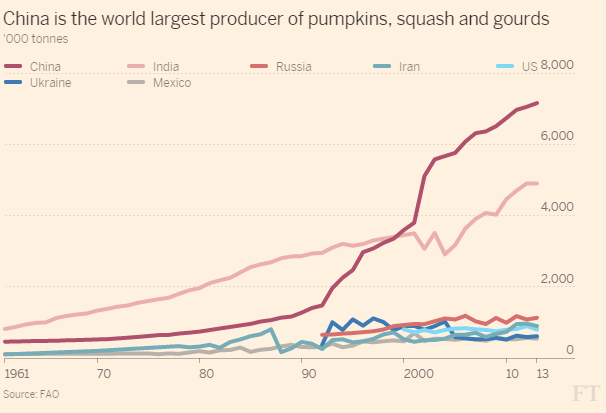
Together with India, the world’s second-largest producer, China accounts for nearly half of global production, while Asia as a whole supplies two thirds of global output.
While China is the world top producer, the US is the world top importer, but not of Chinese pumpkins.
China actually consumes most of its production, while the US imports most of its pumpkins and squash from Mexico. US demand has made Mexico the world’s third-largest exporter after Spain and New Zealand.
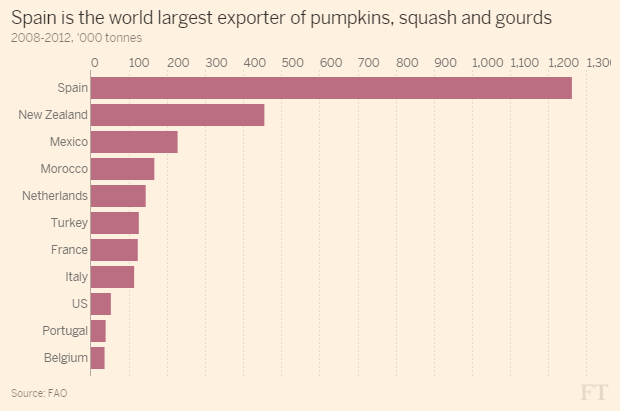
Spain grows pumpkins in about 11,000 hectares of land, about 3 per cent of the area used in China. But productivity is much higher, resulting in production of about 8 per cent that of China. Spain mostly supplies its pumpkins to other European markets with France, Germany and the UK being its largest export markets.
Pumpkins are grown extensively as ornaments for the Halloween festivities, and one variety – the pepo- is grown exclusively to make pumpkin monsters as it’s not good to eat and can be easily shaped.
But despite high Halloween demand most production is still for food. Pumpkin and winter squash are ranked among the most nutritious of vegetables with high levels of carotenoids, proteins, minerals and vitamin C. The seeds are consumed as a snack food in many countries, particularly the US. Pumpkins are also grown as food for catle.
Source: http://blogs.ft.com/ftdata/2015/10/31/china-produces-the-most-pumpkins-the-us-is-the-largest-importer/?mhq5j=e1
 F) Prices in Europe/ world
F) Prices in Europe/ world

 G) Recipes with Pumpkin
G) Recipes with Pumpkin
https://docs.google.com/presentation/d/1SJL7VRv4KqUN0aW8aKR8x3Ao88PAYXZWT4mw5LaKs20/edit#slide=id.g214514b6ec_0_55
 H) Science experiment 1: Search a science experiment suitable for a pumpkin. Each of the responsible schools does the experiment, and compares the results. (you can invite every person in your group to do the experiment)
H) Science experiment 1: Search a science experiment suitable for a pumpkin. Each of the responsible schools does the experiment, and compares the results. (you can invite every person in your group to do the experiment)

 +
+ I) Science experiment 2: Foodpairing : pumpkin in combination with another (vegetable or fruit )
I) Science experiment 2: Foodpairing : pumpkin in combination with another (vegetable or fruit )
Serbian team from Čačak
Pumpkin has a mild taste, so it tastes good with vanilla, cinnamon, cashew nuts, cloves,coriander, parsley, dill, pepper, salt, sugar, turmeric, white onions, curry, ginger, chilli, apples, plums, cheese, mushrooms, all types of meat, rice. It is often used for soups, creams, jams, cakes.
 J) Health benefits and Nutrional values:
J) Health benefits and Nutrional values:
Group 1 - Potatoes Group 2 - Red Cabbage Group 3 - Spinach Group 4 - Carrots
Group 6- Lemon Group 7 - Grape/ Raisin Group 8 - Orange
Group 9 - Kiwi Group 10 - Banana Group 11 - Beans
